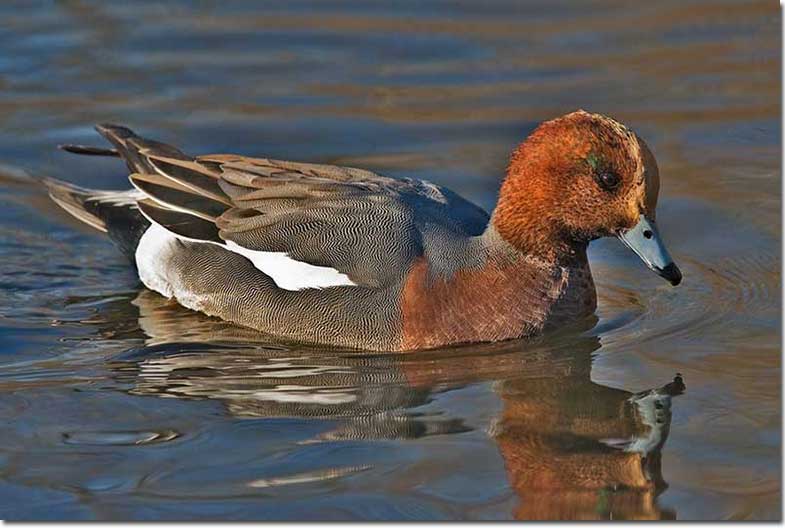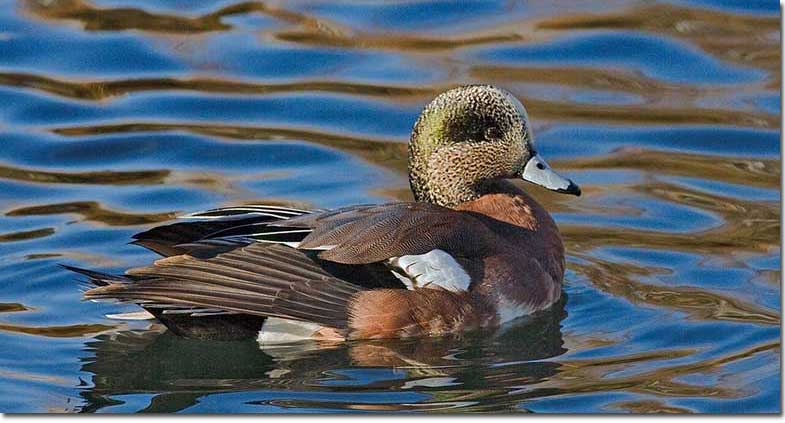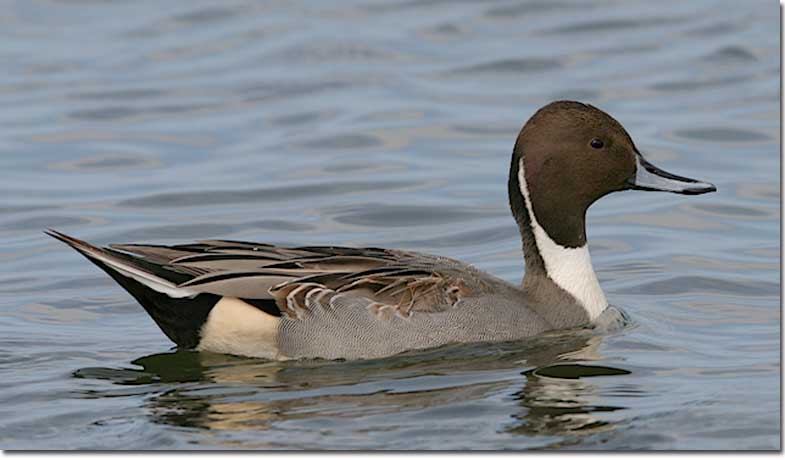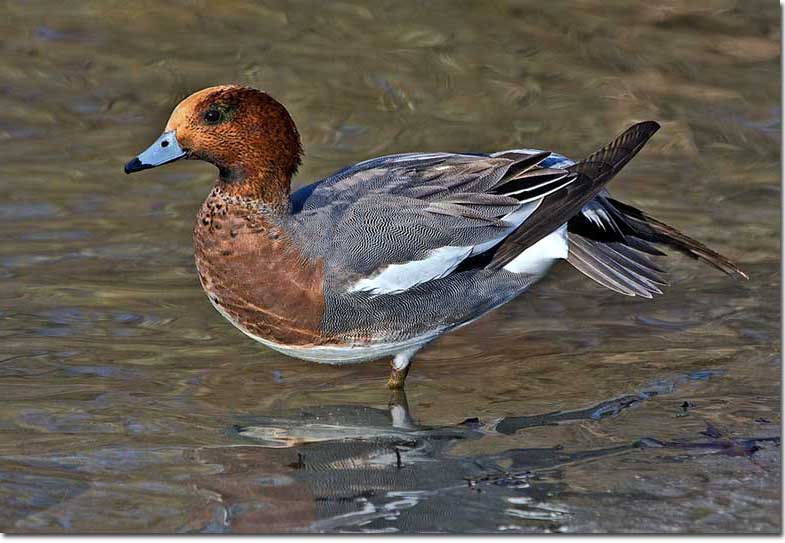Eurasian Wigeon or European Wigeon is a dabbling duck common in Eurasia, but a rare visitor in North America.
If you want to find one in the United States, then try searching among flocks of American Wigeons around the Four Corners and the southern Appalachians.
Identification
An adult male Eurasian Wigeon has a mostly gray back and sides with tiny white stripes that aren’t visible from afar, black rear, a white patch on upper wings and a dark green speculum, a white belly, and a dull pinkish-rusty breast.
Its head is chestnut brown, its throat black and they have a unique creamy forecrown. In its non-breeding plumage, the male is similar to a female, its plumage being reddish-brown, including the rear, but still has that white on its wings. Both sexes have a bluish-gray bill tipped with black.
Male Eurasian Wigeon’s call can be described as short and loud whistling consisting of two notes. Phrases include whee-ooo and wip-weu.

Eurasian Wigeon
Female Eurasian Wigeon has a brown to brown to gray-brown plumage that can appear slightly rust-colored, darker brown wings, and a white belly.
Depending on the morph, the female can have a redder head or a more gray head. Both sexes can have green iridescence on its head, but it’s faint and only visible in sunlight.
When threatened, females give a low growl that sounds similar to errrr.
Food
Eurasian Wigeons are mostly herbivores, feeding in both terrestrial and aquatic environments. They can either forage on land or dabble at the surface of bodies of water.
Sometimes they turn upside down and are halfway submerged to reach the food at the bottom and then return to the surface to eat. It may eat both during the day and at night.
Their diet includes leaves, stems, rhizomes, roots, and seeds of different plants, such as fringed water lily, water crowfoot, wigeon grass, and duckweed. On land, they can be seen carefully working through one small area or walking around and picking food on the way.
During the breeding season, they can also eat insects, such as mayflies or beetles, and tiny underwater creatures. Females and ducklings are quite dependent on them during the summer.
Nesting and Eggs
Eurasian Wigeons pair up for one breeding season and find another mate for the next one. Several males may compete for one female by putting on a display.
That can include displaying their fluffy forecrown, lifting the tips of their folded wings, and whistling a call while raising their head. The males defend their females until the females begin incubating, but then leave, form flocks with other males, and start molting.
The females prefer to build their nest near a body of water under something that offers some cover. The nest itself is a shallow depression on the ground, which the female lines with grass and its own down.
The female then lays 6-12, but most commonly 8-9 whitish to pale creamy eggs that are about 2 inches long and 1.3-1.5 inches wide. The incubation takes 23-25 days and the young leave the nest shortly after hatching, taking their first flight about 40-45 days after hatching.
All the care from incubation to raising the younglings is done by the female, although the young have to find food on their own, the female provides protection.
Current Situation
Eurasian Wigeons range from Iceland across northern Europe and Asia and they are mostly migratory. During the breeding seasons, they can be found in different wetlands, such as ponds, lakes, and freshwater marshes that have a lot of submerged vegetation.
After the breeding season, Eurasian Wigeon’s migration brings them from the northern part of the Palearctic down south.
They may also fly over the ocean to North America, where they prefer to live together with American Wigeons in freshwater lakes, marshes, saltmarshes, bays, and other coastal sites, but also in overflooded grasslands and tidal mud flats. They can also show up at lakes that are at high elevations, as long as they are not completely frozen over.
In North America, they are quite rare but widespread within their range in Eurasia. The IUCN Red List has them listed as species of Least Concern.
Although there has been a slight decrease in numbers due to hunting, drainage of wetlands, and other human developments in their habitats, then their population appears to be quite stable for now.
Facts
- The species got its scientific name penelope from Greek Mythology. Odysseus’s wife Penelope was thrown into the ocean and then rescued by a duck.
- The oldest known Eurasian Wigeon lived to be 35 years and 2 months old. The oldest in recorded in North America was 10 years and 7 months old.
- Eurasian Wigeons go through molt which leaves them flightless for a short period of time. They molt after breeding. During that time, males form flocks and females raise the young on their own. Females and fledglings join the males later, just before migration.
- Since Eurasian Wigeons join flocks of American Wigeons, they can sometimes interbreed and produce hybrids of the two.
Similar Species
The male Eurasian Wigeon doesn’t have many similar species, only two, although the female may look similar to many more females from different duck species.

American Wigeon
Eurasian Wigeons like to integrate into flocks of American Wigeons.
They can look similar in shape but are actually quite different. American Wigeons have a grayish-brown face and neck with specks of white, and green eye stripes, and a white forehead. Eurasian Wigeons, on the other hand, have a chestnut head with a creamy forecrown.
Eurasian Wigeons are also mainly gray, whereas the American Wigeon has warmer rust-colored plumage. Female Eurasian Wigeon has a lighter and warmer-toned head than a female American Wigeon.
They’re very difficult to separate, but when in flight, it is best to look at their underwing color, which is a bit dirty on Eurasian Wigeons and white on American Wigeons.
Like females, the nonbreeding male Eurasian Wigeon has a warm chestnut head, whereas the American has a brownish-gray head.

Northern Pintail
The Northern Pintail has a similar coloring with its body being gray and head being chestnut brown.
However, their throat is white, and they have a white neck stripe, compared to the Eurasian Wigeon’s fully chestnut head and neck.
They’re also common across all of North America, so if you think you saw a Eurasian Wigeon, you might’ve mixed them up with a Northern Pintail.
FAQ
Where do Eurasian Wigeon migrate?
Eurasian Wigeon breeds in the northern areas of Europe and the Palearctic and migrates further south during the winter. The migrants reaching North America are believed to start their journey from Iceland.
Can Wigeons fly?
Wigeons can fly but during the summer, after breeding and leaving their mates, they go through a molt that leaves them flightless for a while.

